Spatial–Temporal Evolution of Socio-Ecological System Vulnerability on the Loess Plateau under Rapid Urbanization
Abstract
:1. Introduction
2. Study Area and Data Sources
2.1. Study Area
2.2. Data Sources
3. Methods
3.1. Evaluation Index System of the SES’s Vulnerability
3.2. Evaluation Methods for SES’s Vulnerability
- (1)
- Data standardization. First, in order to eliminate the influence caused by the different magnitudes of indicators, the indicators are standardized by using the extreme difference standardization. The standardization formula of positive term indicators is:
- (2)
- Evaluation index assignment. The entropy weight method can overcome the problem of randomness and speculation that cannot be avoided by the subjective assignment method, can also effectively solve the problem of overlapping information among multiple indicator variables, and can deeply reflect the utility value of the entropy value of indicator information, which has strong objectivity and is widely used in social economy and other research fields [51]. Therefore, this study adopted entropy weight method for index assignment, and its evaluation idea is that, the greater the difference between the values of evaluation objects in a certain index, the more important the object is, and the greater the weight value. The specific formula is as follows:
- (3)
- Integrated index method. Combining the index weights and standardized values, the exposure, sensitivity, and adaptive capacity of the SES of each study unit were calculated separately using the weighted summation method, and then the vulnerability index was calculated. The specific formula is as follows:
3.3. Classification of the SES’s Vulnerability
3.4. Dominant Factor Method
4. Results
4.1. Spatial–Temporal Variation in the SES’s Vulnerability
4.2. Spatial–Temporal Variation in the Dimensions of the SES’s Vulnerability
4.2.1. Spatial–Temporal Variation in the SES’s Exposure
4.2.2. Spatial–Temporal Variation in the SES’s Sensitivity
4.2.3. Spatial–Temporal Variation in the SES’s Adaptive Capacity
4.3. Identification of Dominant Factors of the SES’s Vulnerability
5. Discussion
6. Conclusions and Policy Recommendations
Author Contributions
Funding
Institutional Review Board Statement
Informed Consent Statement
Data Availability Statement
Conflicts of Interest
References
- Zou, C.; Zhu, J.; Lou, K.; Yang, L. Coupling coordination and spatiotemporal heterogeneity between urbanization and ecological environment in Shaanxi Province, China. Ecol. Indic. 2022, 141, 109152. [Google Scholar] [CrossRef]
- Wang, X.; Long, W.; Sang, M.; Yang, Y. Towards Sustainable Urbanization: Exploring the Influence Paths of the Urban Environment on Bidders’ Collusive Willingness. Land 2022, 11, 280. [Google Scholar] [CrossRef]
- Fang, C.; Cui, X.; Liang, L. Theoretical analysis of urbanization and eco-environment coupling coil and coupler control. Acta Geogr. Sin. 2019, 74, 2529–2546. (In Chinese) [Google Scholar]
- Earth, F. Future Earth Initial Design: Report of the Transition Team; International Council for Science (ICSU): Paris, France, 2013. [Google Scholar]
- Fang, C.; Wang, Y.; Fang, J. A comprehensive assessment of urban vulnerability and its spatial differentiation in China. Acta Geogr. Sin. 2015, 70, 234–247. (In Chinese) [Google Scholar] [CrossRef]
- Kriewald, S.; Pradhan, P.; Costa, L.; Ros, A.G.C.; Kropp, J.P. Hungry cities: How local food self-sufficiency relates to climate change, diets, and urbanisation. Environ. Res. Lett. 2019, 14, 094007. [Google Scholar] [CrossRef]
- Sun, X.; Crittenden, J.C.; Li, F.; Lu, Z.; Dou, X. Urban expansion simulation and the spatio-temporal changes of ecosystem services, a case study in Atlanta Metropolitan area, USA. Sci. Total Environ. 2018, 622, 974–987. [Google Scholar] [CrossRef]
- Kates, R.W. Environment and development-Sustainability science. Science 2001, 292, 641. [Google Scholar] [CrossRef]
- Wu, C. On the Core of Geography: Human-Earth Relations in Geographical Systems. Econ. Geogr. 1991, 3, 1–6. (In Chinese) [Google Scholar]
- Grimm, N.B.; Faeth, S.H.; Golubiewski, N.E.; Redman, C.L.; Wu, J.; Bai, X.; Briggs, J.M. Global change and the ecology of cities. Science 2008, 319, 756–760. [Google Scholar] [CrossRef] [Green Version]
- Siciliano, G. Urbanization strategies, rural development and land use changes in China: A multiple-level integrated assessment. Land Use Policy 2012, 29, 165–178. [Google Scholar] [CrossRef]
- Zeng, L.; Zhao, Y.; Wang, X. How to develop the new urbanization in mineral resources abundant regions in China? A VIKOR-based path matching model. Resour. Policy 2022, 79, 103095. [Google Scholar] [CrossRef]
- He, W.; Li, X.; Yang, J.; Ni, H.; Sang, X. How land use functions evolve in the process of rapid urbanization: Evidence from Jiangsu Province, China. J. Clean. Prod. 2022, 380, 134877. [Google Scholar] [CrossRef]
- Cumming, G.S.; Barnes, G.; Perz, S.; Schmink, M.; Sieving, K.E.; Southworth, J.; Binford, M.; Holt, R.D.; Stickler, C.; Van Holt, T. An exploratory framework for the empirical measurement of resilience. Ecosystems 2005, 8, 975–987. [Google Scholar] [CrossRef]
- Adger, W.N. Vulnerability. Glob. Environ. Chang. 2006, 16, 268–281. [Google Scholar] [CrossRef]
- Turner, B.L.; Kasperson, R.E.; Matson, P.A.; McCarthy, J.J.; Corell, R.W.; Christensen, L.; Eckley, N.; Kasperson, J.X.; Luers, A.; Martello, M.L. A framework for vulnerability analysis in sustainability science. Proc. Natl. Acad. Sci. USA 2003, 100, 8074–8079. [Google Scholar] [CrossRef] [PubMed] [Green Version]
- Li, H.; Zhang, P.; Cheng, Y. Concepts and assessment methods of vulnerability. Prog. Geogr. 2008, 27, 18–25. (In Chinese) [Google Scholar]
- Li, H.; Zhang, P. Research progress and prospective applications of vulnerability approach under global change. Prog. Geogr. 2011, 30, 920–929. (In Chinese) [Google Scholar]
- He, Y.; Huang, X.; Yang, X. Social Vulnerability Assessment of Land-Lost Households in Urban Fringe of Xi’an. Econ. Geogr. 2017, 37, 149–157. [Google Scholar]
- Turner, B.L.; Matson, P.A.; McCarthy, J.J.; Corell, R.W.; Christensen, L.; Eckley, N.; Hovelsrud-Broda, G.K.; Kasperson, J.X.; Kasperson, R.E.; Luers, A. Illustrating the coupled human–environment system for vulnerability analysis: Three case studies. Proc. Natl. Acad. Sci. USA 2003, 100, 8080–8085. [Google Scholar] [CrossRef] [Green Version]
- Yu, R.; Liang, L.; Su, X.; Cheng, J. A driver based framework for vulnerability assessment of the poverty stricken areas of Funiu Mountain, China. Ecol. Indic. 2020, 113, 106209. [Google Scholar] [CrossRef]
- Peng, Y.; Welden, N.; Renaud, F.G. A framework for integrating ecosystem services indicators into vulnerability and risk assessments of deltaic social-ecological systems. J. Environ. Manag. 2023, 326, 116682. [Google Scholar] [CrossRef] [PubMed]
- Yang, Z.; Li, B.; Nan, B.; Dai, X.; Peng, C.; Bi, X. A methodological framework for assessing pastoral socio-ecological system vulnerability: A case study of Altay Prefecture in Central Asia. Sci. Total Environ. 2023, 862, 160828. [Google Scholar] [CrossRef] [PubMed]
- Yang, X.; Dai, X.; Li, W.; Lu, H.; Liu, C.; Li, N.; Yang, Z.; He, Y.; Li, W.; Fu, X.; et al. Socio-Ecological Vulnerability in Aba Prefecture, Western Sichuan Plateau: Evaluation, Driving Forces and Scenario Simulation. ISPRS Int. J. Geo-Inf. 2022, 11, 524. [Google Scholar] [CrossRef]
- Li, Z.; Deng, X.; Zhang, Y. Evaluation and convergence analysis of socio-economic vulnerability to natural hazards of Belt and Road Initiative countries. J. Clean. Prod. 2021, 282, 125406. [Google Scholar] [CrossRef]
- Gupta, A.K.; Negi, M.; Nandy, S.; Kumar, M.; Singh, V.; Valente, D.; Petrosillo, I.; Pandey, R. Mapping socio-environmental vulnerability to climate change in different altitude zones in the Indian Himalayas. Ecol. Indic. 2020, 109, 105787. [Google Scholar] [CrossRef]
- Snyder, B.F.; Parks, V. Spatial variation in socio-ecological vulnerability to Covid-19 in the contiguous United States. Health Place 2020, 66, 102471. [Google Scholar] [CrossRef] [PubMed]
- Dasgupta, S.; Badola, R.; Ali, S.Z.; Jiju, J.S.; Tariyal, P. Adaptive capacity and vulnerability of the socio-ecological system of Indian Himalayan villages under present and predicted future scenarios. J. Environ. Manag. 2022, 302, 113946. [Google Scholar] [CrossRef]
- Liu, C.; He, Q.; Li, Y. Spatiotemporal Evaluation of Socio-Ecological-Economic System Vulnerability: A County-Level Analysis of Chongqing, China. Sustainability 2020, 12, 3912. [Google Scholar] [CrossRef]
- Zhang, J.; Li, J.; Yang, X.; Yin, S.; Chen, J. Rural social-ecological systems vulnerability evolution and spatial-temporal heterogeneity in arid environmental change region: A case study of Minqin Oasis, northwestern China. Appl. Geogr. 2022, 145, 102747. [Google Scholar] [CrossRef]
- Damian, N.; Mitrică, B.; Mocanu, I.; Grigorescu, I.; Dumitraşcu, M. An index-based approach to assess the vulnerability of socio-ecological systems to aridity and drought in the Danube Delta, Romania. Environ. Dev. 2022, 45, 100799. [Google Scholar] [CrossRef]
- Han, X.; Wang, P.; Wang, J.; Qiao, M.; Zhao, X. Evaluation of human-environment system vulnerability for sustainable development in the Liupan mountainous region of Ningxia, China. Environ. Dev. 2020, 34, 100525. [Google Scholar] [CrossRef]
- Jha, S.K.; Negi, A.K.; Alatalo, J.M.; Negi, R.S. Socio-ecological vulnerability and resilience of mountain communities residing in capital-constrained environments. Mitig. Adapt. Strateg. Glob. Chang. 2021, 26, 38. [Google Scholar] [CrossRef] [PubMed]
- Grigorescu, I.; Mocanu, I.; Mitrică, B.; Dumitraşcu, M.; Dumitrică, C.; Dragotă, C.S. Socio-economic and environmental vulnerability to heat-related phenomena in Bucharest metropolitan area. Environ. Res. 2021, 192, 110268. [Google Scholar] [CrossRef] [PubMed]
- Zhao, X.; Ma, P.; Li, W.; Du, Y. Spatiotemporal changes of supply and demand relationships of ecosystem services in the Loess Plateau. Acta Geogr. Sin. 2021, 76, 2780–2796. (In Chinese) [Google Scholar]
- Sun, Y.; Liu, X.; Ren, Z.; Li, S. Spatiotemporal variations of multi-scale drought and its influencing factors across the Loess Plateau from 1960 to 2016. Geogr. Res. 2019, 38, 1820–1832. (In Chinese) [Google Scholar]
- Zhang, J.; Li, C.; Wang, T. Spatial and temporal variation of vegetation cover on the Loess Plateau and its causes. Res. Soil Water Conserv. 2022, 29, 224–230+241. (In Chinese) [Google Scholar]
- Zhang, L.; Fan, J.; Zhang, H.; Zhou, D. Spatial-temporal Variations and Their Driving Forces of the Ecological Vulnerability in the Loess Plateau. Environ. Sci. 2022, 43, 4902–4910. (In Chinese) [Google Scholar]
- Jiang, S.; Zhou, J.; Qiu, S. Digital Agriculture and Urbanization: Mechanism and Empirical Research. Technol. Forecast. Soc. Chang. 2022, 180, 121724. [Google Scholar] [CrossRef]
- Wei, L.; Zhou, L.; Sun, D.; Tang, X. The evolution of spatio-temporal pattern and scenario simulation of urban agglomeration expansion in the Yellow River Basin: A case study in the Hohhot-Baotou-Ordos-Yulin Urban Agglomeration. Geogr. Res.-Aust. 2022, 41, 1610–1622. [Google Scholar]
- Polsky, C.; Neff, R.; Yarnal, B. Building comparable global change vulnerability assessments: The vulnerability scoping diagram. Glob. Environ. Chang. 2007, 17, 472–485. [Google Scholar] [CrossRef]
- Chen, J.; Yang, X.; Yin, S.; Wu, K. The vulnerability evolution and simulation of the social-ecological systems in the semi-arid area based on the VSD framework. Acta Geogr. Sin. 2016, 71, 1172–1188. (In Chinese) [Google Scholar]
- Yang, Y.; Li, J.; Wang, L.; Wang, Z.; Yao, C.; Wang, Y. Impact of urbanization on supply and demand of typical ecosystem services in Yangtze River Delta. J. Nat. Resour. 2022, 37, 1555–1571. [Google Scholar] [CrossRef]
- Zhao, Y.; Shi, Y.; Feng, C.-C.; Guo, L. Exploring coordinated development between urbanization and ecosystem services value of sustainable demonstration area in China- take Guizhou Province as an example. Ecol. Indic. 2022, 144, 109444. [Google Scholar] [CrossRef]
- Chen, M.; Lu, D.; Zhang, H. Comprehensive evaluation and the driving factors of China’s urbanization. Acta Geogr. Sin. 2009, 64, 387–398. (In Chinese) [Google Scholar]
- Zhang, X.; Song, W.; Wang, J.; Wen, B.; Yang, D.; Jiang, S.; Wu, Y. Analysis on Decoupling between Urbanization Level and Urbanization Quality in China. Sustainability 2020, 12, 6835. [Google Scholar] [CrossRef]
- Hu, Y.; Liu, Y.; Yan, Z. Research Regarding the Coupling and Coordination Relationship between New Urbanization and Ecosystem Services in Nanchang. Sustainability 2022, 14, 15041. [Google Scholar] [CrossRef]
- He, Y.; Huang, X.; Zhai, L.; Yan, Q.; Yang, X. Assessment and influencing factors of social vulnerability to rapid urbanization in urban fringe: A case study of Xi’an. Acta Geogr. Sin. 2016, 71, 1315–1328. (In Chinese) [Google Scholar]
- Huang, X.; Wang, C.; Hu, K. Multi-scale assessment of social vulnerability to rapid urban expansion in urban fringe: A case study of Xi’an. Acta Geogr. Sin. 2018, 73, 1002–1017. (In Chinese) [Google Scholar]
- Li, Z.; Shi, L.; Zhang, C. Vulnerability Assessment and Differentiated Response Strategies of Rural Territorial Systems at the County Level from the Socio-ecological Perspective. Econ. Geogr. 2022, 42, 175–184. (In Chinese) [Google Scholar]
- Tai, X.; Xiao, W.; Tang, Y. A quantitative assessment of vulnerability using social-economic-natural compound ecosystem framework in coal mining cities. J. Clean. Prod. 2020, 258, 120969. [Google Scholar] [CrossRef]
- Xiong, C.; Hu, Y.; Zhou, T.; Tan, R.; Zhang, Y. Impact of provincial infrastructure investment on the vulnerability of social-ecological system in China. Chin. J. Appl. Ecol. 2022, 33, 1395–1404. (In Chinese) [Google Scholar]
- Xing, Z.; Huang, G.; Xue, D. Spatial pattern and influencing mechanism of social integration of migrants in Chinese cities. Acta Geogr. Sin. 2022, 77, 2474–2493. [Google Scholar]
- Wang, C.; He, Y. Spatio-temporal differentiation and differentiated regulation of the vulnerability of rural production space system in Chongqing. Acta Geogr. Sin. 2020, 75, 1680–1698. (In Chinese) [Google Scholar]
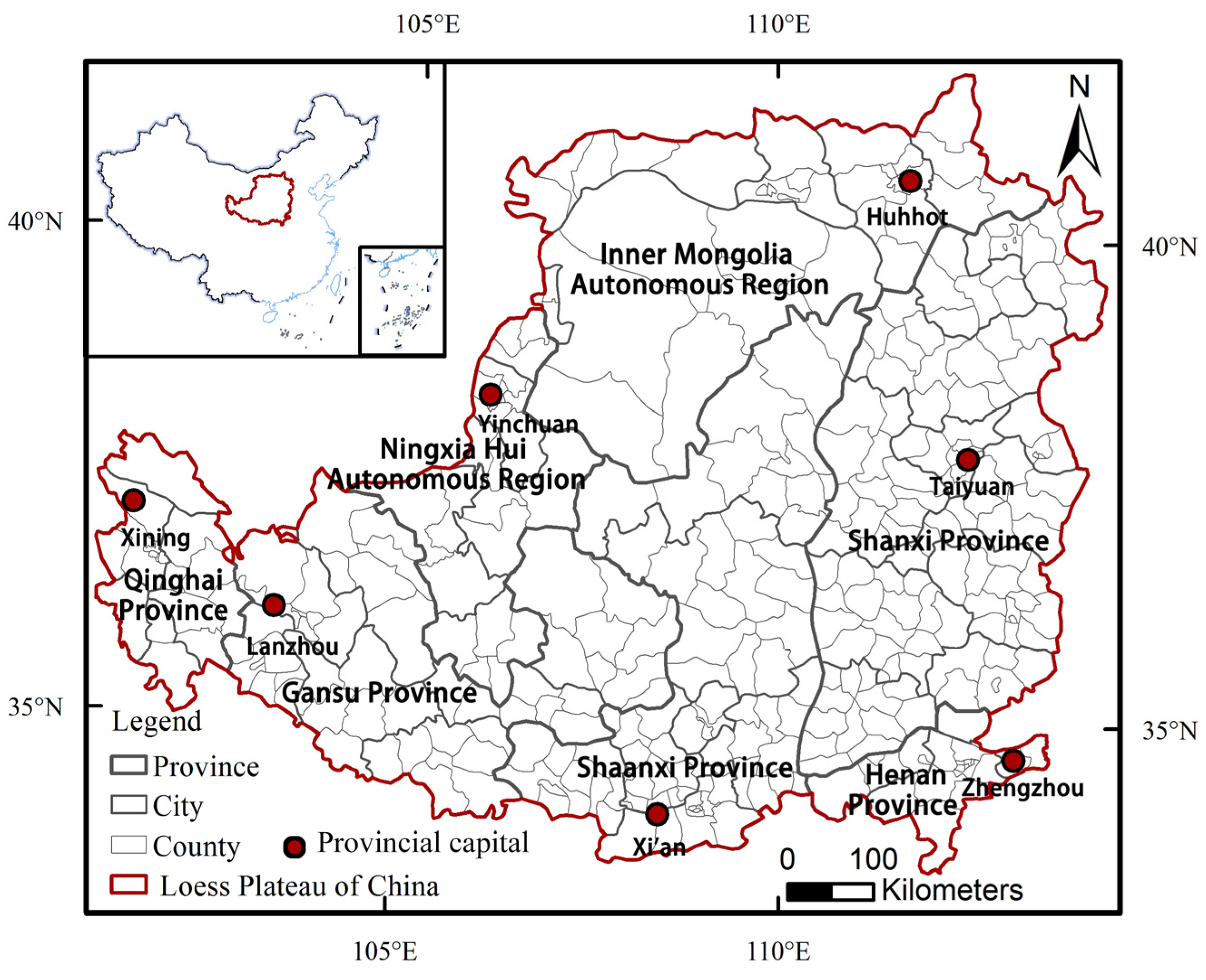
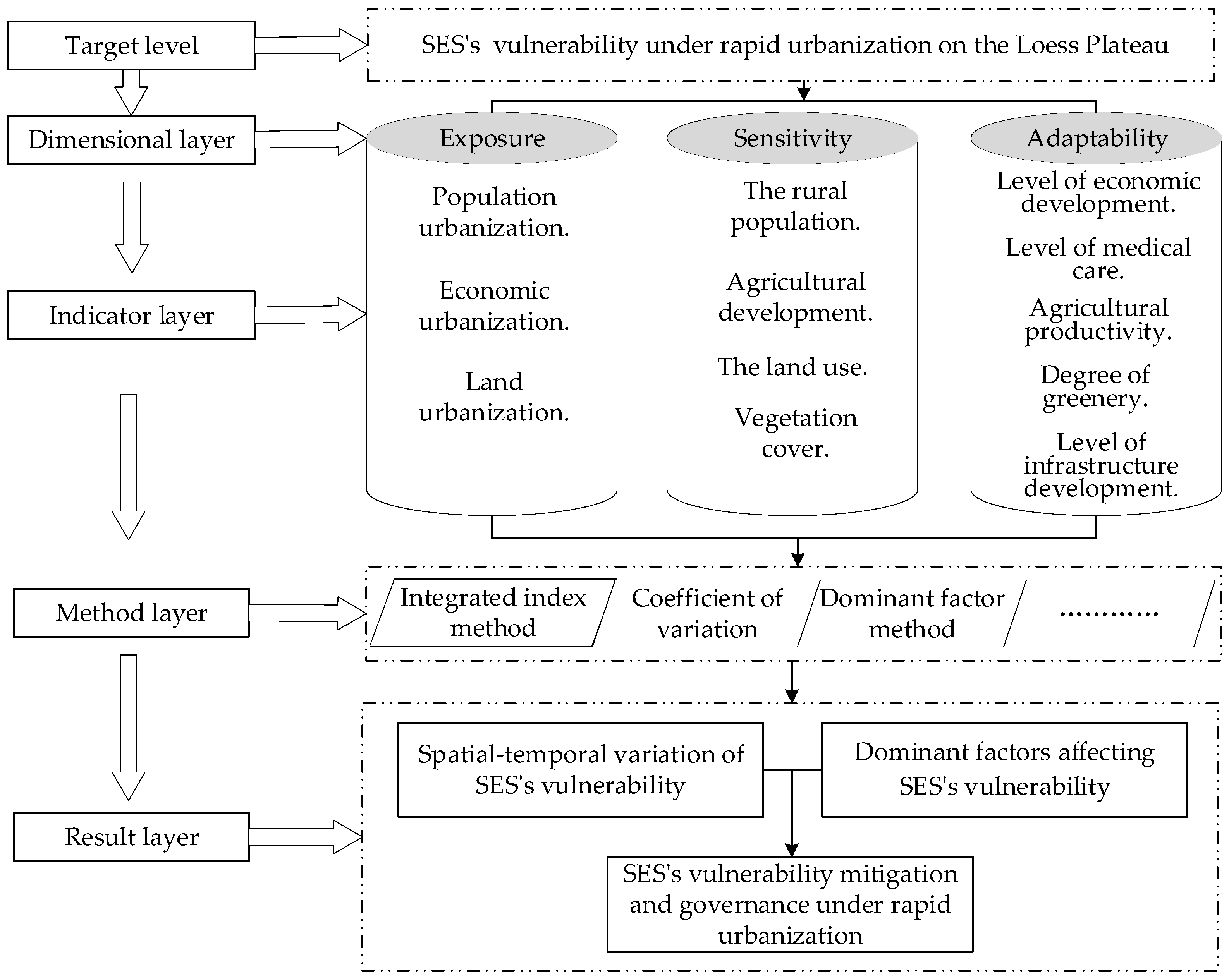

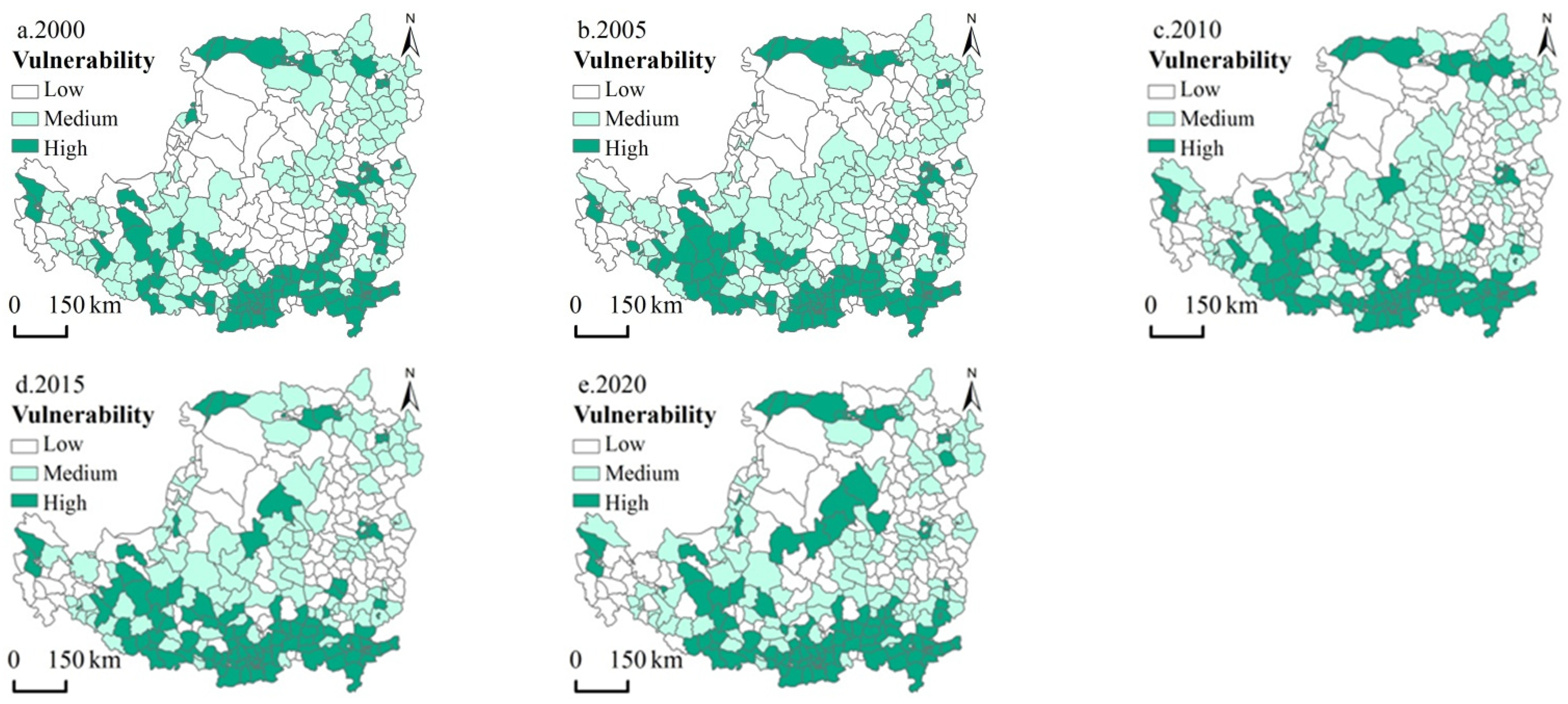

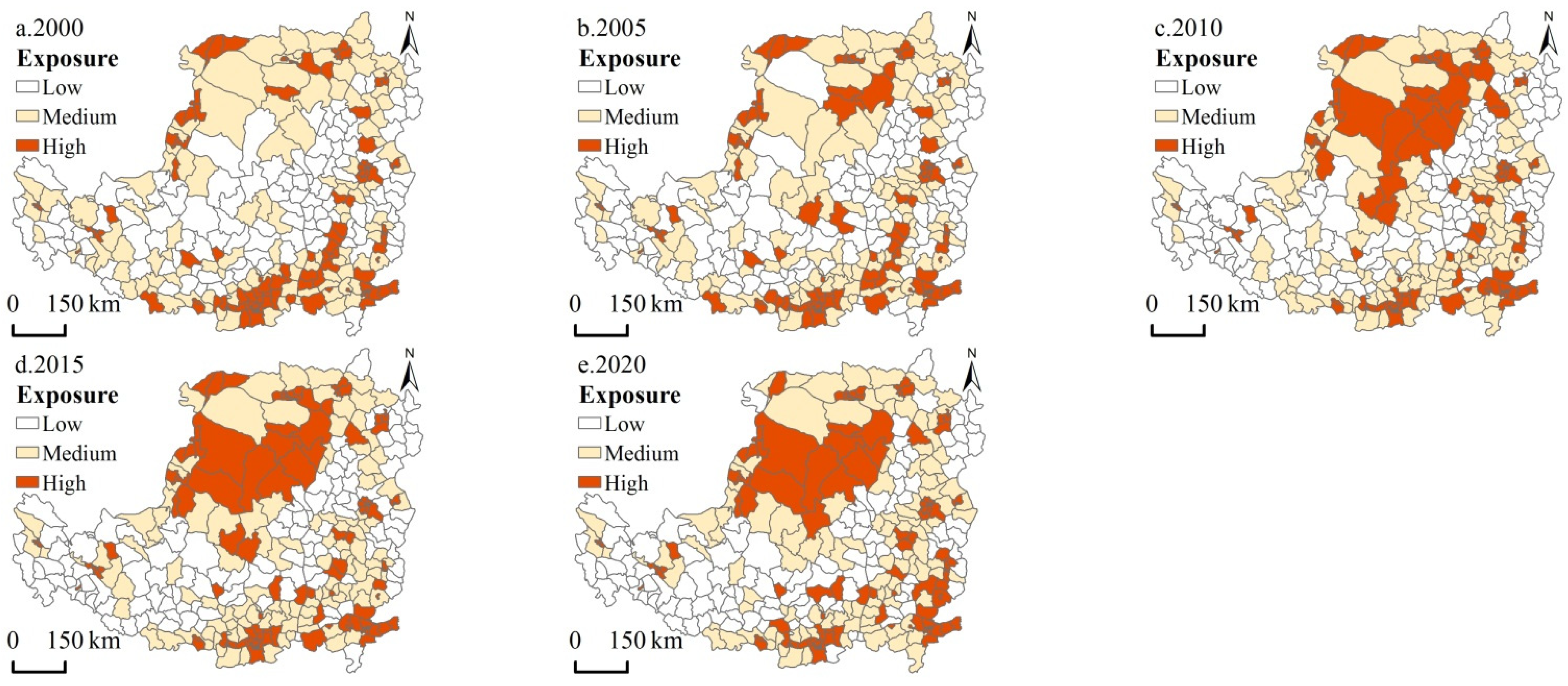

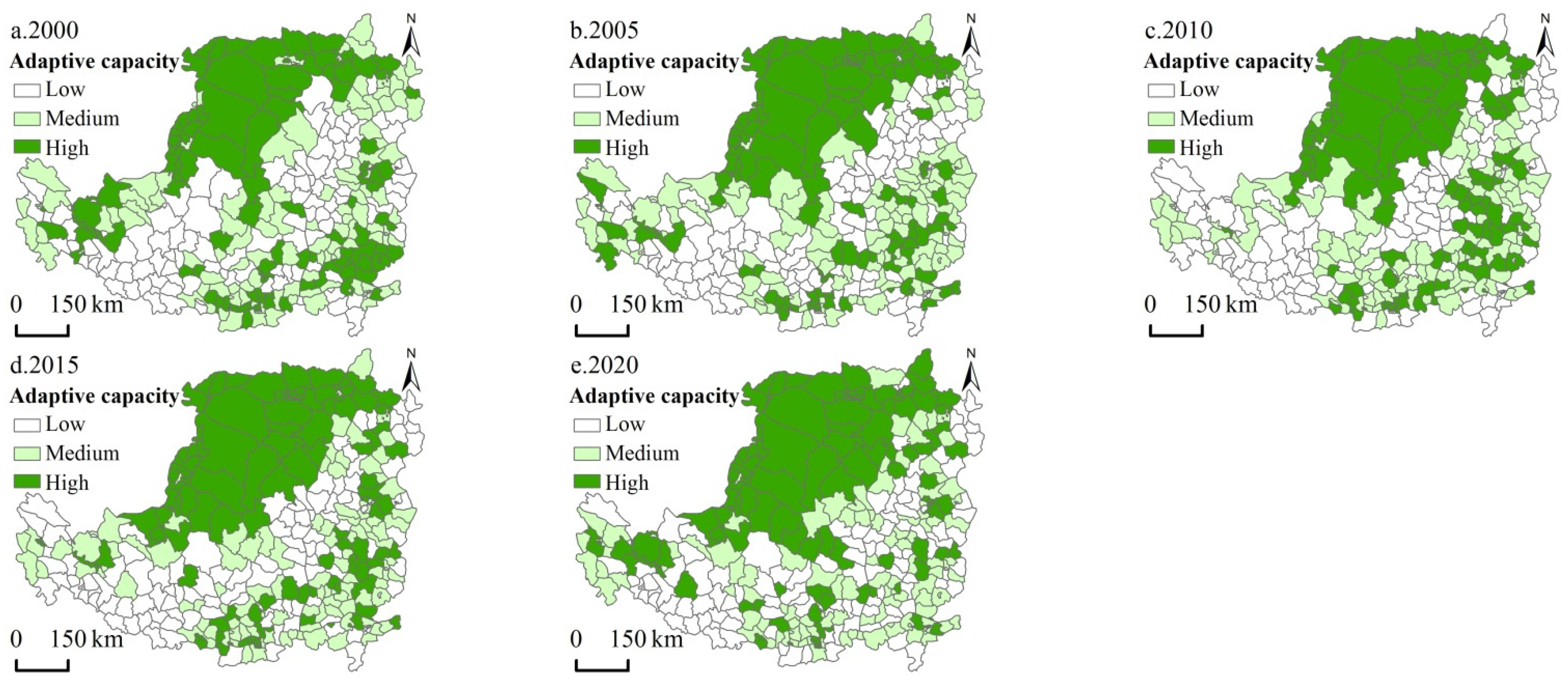

| Dimensional Layers | Indicator Layers | Parameter Layers | Indicator Meaning and Properties | Weight |
|---|---|---|---|---|
| Exposure (+) | Population urbanization | The urban population number | It reflects the degree of disturbance of population urbanization (+) | 0.22 |
| Economic urbanization | Industrial output per capita | It reflects the degree of disturbance of economic urbanization (+) | 0.38 | |
| Land urbanization | The share of construction land area | It reflects the degree of disturbance of land urbanization (+) | 0.40 | |
| Sensitivity (+) | Rural population | The proportion of rural population | Reflecting the sensitive state of the demographic structure (+) | 0.11 |
| Agricultural development | Gross output value of primary industry | Reflecting the sensitive state of industrial structure (+) | 0.47 | |
| Land use | Arable land per capita | It characterizes the sensitive state of the land space (+) | 0.29 | |
| Vegetation cover | Normalized difference vegetation index (NDVI) | It reflects the sensitive state of the ecological environment (−) | 0.13 | |
| Adaptive capacity (−) | Regional economic development | Gross regional product per capita | It reflects the regional economic strength and financial accumulation capacity (+) | 0.23 |
| Resident income | Net income per urban resident | It reflects the income level of urban residents (+) | 0.11 | |
| Medical Coverage | Number of medical beds per 10,000 people | It reflects the level of regional medical services (+) | 0.14 | |
| Convenience of travel | Road area per capita | It reflects the accessibility of the region (+) | 0.09 | |
| Agricultural productivity | Food production per capita | It reflects the level of productivity (+) | 0.13 | |
| Environmental Investment | The share of environmental expenditures in regional GDP | It reflects the strength of regional ecological protection(+) | 0.17 | |
| Degree of greenery | The area of green space per capita | It reflects the degree of ecological improvement(+) | 0.13 |
Disclaimer/Publisher’s Note: The statements, opinions and data contained in all publications are solely those of the individual author(s) and contributor(s) and not of MDPI and/or the editor(s). MDPI and/or the editor(s) disclaim responsibility for any injury to people or property resulting from any ideas, methods, instructions or products referred to in the content. |
© 2023 by the authors. Licensee MDPI, Basel, Switzerland. This article is an open access article distributed under the terms and conditions of the Creative Commons Attribution (CC BY) license (https://creativecommons.org/licenses/by/4.0/).
Share and Cite
Ma, P.; Zhao, X.; Li, H. Spatial–Temporal Evolution of Socio-Ecological System Vulnerability on the Loess Plateau under Rapid Urbanization. Sustainability 2023, 15, 2059. https://doi.org/10.3390/su15032059
Ma P, Zhao X, Li H. Spatial–Temporal Evolution of Socio-Ecological System Vulnerability on the Loess Plateau under Rapid Urbanization. Sustainability. 2023; 15(3):2059. https://doi.org/10.3390/su15032059
Chicago/Turabian StyleMa, Pingyi, Xueyan Zhao, and Hua Li. 2023. "Spatial–Temporal Evolution of Socio-Ecological System Vulnerability on the Loess Plateau under Rapid Urbanization" Sustainability 15, no. 3: 2059. https://doi.org/10.3390/su15032059




